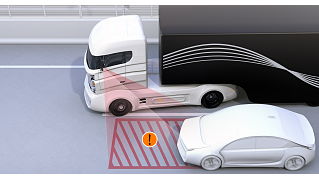





As part of the Direct Vision Standard (DVS) and safety permit for heavy goods vehicles (HGVs) to operate in Greater London, all vehicles must meet a minimum star rating of one star (increasing to a minimum of three stars in 2024). Zero rated vehicles must be fitted with various mitigating safety features, including a fully operational camera monitoring system fitted to the nearside. WEBFLEET.connect partner integrations allow fleet operators to choose from a range of trusted partner solutions, combining more telematics and safety features with our award-winning platform to help you comply with the Direct Vision Standard (DVS).
How Webfleet can help with DVS compliance
Integrate cameras, active monitoring sensors, vehicle checks, and telematics all under one roof.
Choose from a range of tried and tested .connect partner solutions.
Comply with nearside live monitoring required for a Direct Vision Standard (DVS) star rating.
Combine Webfleet award-winning GPS data with video footage for incident reporting.
Utilise in-cab devices for video feeds and indicator-on situations.
Cloud-based storage and security for both telematics and video data.
Key telematics and safety features
Blind spot vision
Our integrated camera partners can aid blind spot vision and help operators to comply with the Direct Vision standard (DVS). Multiple camera systems and in-cab monitors are available to aid the driver’s in-cab vision without obstructing their view out of the windscreen. Live camera footage from the vehicle can also be streamed to HQ for added peace of mind.


Active monitoring system
Our camera solutions partners can include side sensors to detect if a pedestrian, cyclist or motorcyclist is alongside the vehicle, alerting the driver to their presence. Recorded ‘event’ footage can be sent to the fleet manager for an instant assessment of the situation.
Vehicle DVS compliance checks
The Direct Vehicle Standard legislation mandates that regular vehicle checks take place to ensure that all equipment installed to meet the DVS criteria is functional and in the correct place. Webfleet works with select partners to offer customisable integrated vehicle check applications, helping fleets to maintain DVS compliance.


Vehicle management and location reporting
Identifying vehicles moving in and out of the DVS zone can be a challenge for fleet operators. With Webfleet’s award-winning tracking and vehicle data you can easily identify which vehicles are moving within the affected area and act accordingly. Geo-fencing can automatically alert operators and our cloud-based platform keeps your data secure and accessible wherever you are.
Requirements to achieve direct vision standard
Direct vision standard map
From October 2020, all HGVs over 12 tonnes are required to have an HGV safety permit to enter and operate throughout the London area. In the following map, you can find the DVS enforcement zones. In these areas, you will need an HGV safety permit to drive at all times.
Direct vision standard equipment
There are various types of direction vision standard equipment that you will need to have fitted to your vehicle in order to comply with DVS. This equipment helps ensure your vehicle is secure on the road, improving safety for both the driver and other road users.
Depending on the age and model of your vehicle, the items you will need to add to it will vary. However, here is a list of some of the equipment required:
- Class V and VI mirrors
- A camera monitoring system with blind-spot cameras
- Close-proximity sensors that alert the driver
- Side under-run protection on both sides
- Audible alert for vehicle turning
- Pictorial warning signage
HGV safety permit
All HGVs will need a safety permit to travel in the areas highlighted in the map above. The manner in which this permit is granted is built around the star rating system. The star rating system determines how much or how little is visible to the driver from their position in the cab.
If a vehicle has anything between one and five stars, you can apply for an HGV safety permit without providing any further evidence to back up the application. If your vehicle has no stars, however, you will first need to make adjustments to it before you can apply. In particular, you will need to fit it with Safe System equipment, as outlined by TFL.
If you do not know the star rating of your vehicle, you will need to contact the vehicle’s manufacturer to find out its rating before applying.
Our Direct Vision Standard (DVS) partners
Request a demo
See how Webfleet and partner integrations can help you to achieve DVS compliance






Your consent is required
In this section, external content is being embedded from .
To display the content, your consent is required for the following cookie categories:
- Targeted Advertising
- Analytics & Personalization
- Essential
For further details, please refer to our privacy policy. If you are interested in how ###vendor_name### processes your data, please visit their privacy policy.














